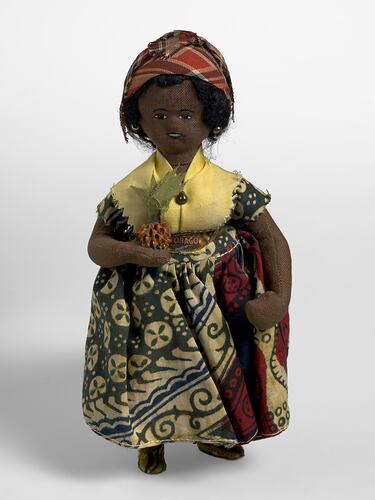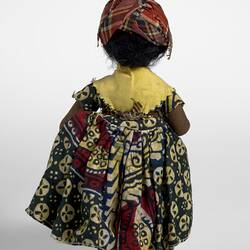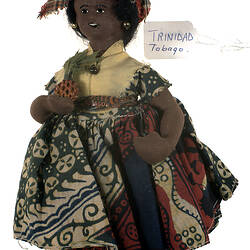Summary
National Doll produced to represent a Trinidadian and Tobagonian women, it was given to Monica Gates, circa 1970s-1980s. In 2000 Afro-Trinidadian and Tobagonians made up 39.5% of the population of Trinidad and Tobago. However the island of Trinidad contains much of the country's population (approximately 95%) and is more culturally and ethnically diverse compared to the island of Tobago which has a smaller population largely composed of Afro-Trinidadian and Tobagonians. The doll is dressed in clothing 'typically' worn by Afro-Trinidadian and Tobagonian women, particularly during the 19th and early 20th Centuries. This dress is similar to that typically worn by women of African descent living throughout the Caribbean and South America, a long dress, or a long skirt and blouse, a shawl and headdress. Madras head-ties were worn by many women of African descent across the Caribbean, particularly during the 19th and early 20th Centuries. The name comes from the type of fabric originally used, a lightweight plaid cotton, originally called Madras, which was often worn elaborately knotted.
The Gates collection contains 170 national dolls from 74 different countries and some correspondence relating to the acquisition of several of the dolls. The costumes of the dolls represent national costumes from the 19th Century to the 1990s. Monica Gates collected or was given these dolls between 1957 and 1990.
These dolls were purchased as souvenirs of particular countries and like many mass produced souvenirs they are often not accurate representations of a particular country or region, and may actually better reflect neighbouring counties or regions. This occurs because costumes are often stylised and simplified resulting dolls wearing generic costume elements which are common to many countries/regions. Often the fabrics and decorations used are selected to make the dolls cheap and easy to manufacture and aesthetically pleasing. This can result in the fabrics, colours and decorations of the doll's clothing having little or no reflection of the costume associated with a particular country or region they are meant to be representative of.
Physical Description
Female wearing a blue, red, yellow, cream and green patterned dress. Around her waist she has and orange belt. Over her shoulders is a yellow scarf secured at the front with a brooch. She has a petticoat under her dress which is cream with red netting around the bottom. In her hand she holds a pineapple. Her black hair is tied up under a red tartan scarf. She has gold ear- rings. Her facial features are painted on.
More Information
-
Collecting Areas
-
Acquisition Information
Purchase
-
Place Made
-
User
-
Other Association (See Comments)
Trinidad & Tobago
Doll is intended to represent a typical Afro-Trinidadian and Tobagonian woman. -
Inscriptions
On the belt around her waist - TOBAGO
-
Classification
-
Category
-
Discipline
-
Type of item
-
overall dimensions
9 cm (Length), 10 cm (Width), 20 cm (Height)
-
Keywords
Children's Play, Clothing, Cultural Awareness, Cultural Beliefs, Dolls, National Costumes, National Identity, Souvenirs




